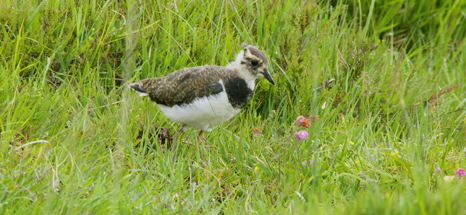 Rare wading birds have been spotted in New Forest wetland habitat that was recently restored.
Rare wading birds have been spotted in New Forest wetland habitat that was recently restored.
The lapwing chicks were feeding at a stream near Stoney Cross, which was restored to its naturally shallow, winding state in 2014.
A sighting of juvenile lapwing in the south of England is rare, as the species has declined by 48% in the last 25 years1. They are often disturbed by people, attacked by predators or suffer from loss of habitat, putting them on the RSPB’s red list of threatened species.
The New Forest Keeper in the area has been working hard to ensure that the Lapwings survive the nesting season by controlling carrion in the area and monitoring the nest site.
Birds like lapwing, curlew and redshank head to the New Forest’s wetlands from March to July as its wet and open areas are perfect for breeding. For many years these habitats have been disappearing across the south of England, but our wetland restoration schemes are working to reverse this trend.
The two young chicks sighted near Stoney Cross have now flown the nest after benefiting from the improved streamside habitat provided by our restoration, which involved raising the bed levels and reinstating natural bends.
Since 2010 more than nine miles of waterways have been restored improving the damage caused by artificial straightening of streams since the Victorian era. This work is funded by the New Forest Higher Level Stewardship (HLS) Scheme.
Andy Page, Head of Wildlife Management at the Forestry Commission, said: ‘Lapwing and other breeding waders need wetland habitats to provide feeding areas for their chicks at this time of year. It’s so rewarding to see these chicks using the natural streams and wet margins that the HLS scheme has been restoring, which is vital habitat for ground-nesting birds in the New Forest.’
‘Numbers of lapwing have been falling over recent years, so it’s encouraging to see these chicks as a sign that our hard work may be paying off, although we still have some way to go to restore waterways and improve the number of ground-nesting bird numbers in the area. By restoring the habitat to prime condition and the public using the Forest considerately we are all giving these birds the best chance of success that we can.’
Research has found that HLS work on ‘maintaining and, where possible, enhancing the water-holding ability of the various mire systems within the New Forest is crucial to maintaining viable populations of breeding waders2.’
The 10-year HLS agreement with Natural England is held by the Verderers of the New Forest. The scheme is managed by them in partnership with the Forestry Commission and the New Forest National Park Authority.
To find out more about the work of the HLS scheme in the New Forest visit www.hlsnewforest.org.uk.
-ENDS-